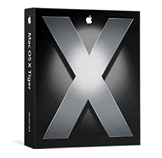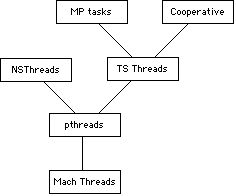No more mysteries: Apple's G5 versus x86, Mac OS X versus Linux
by Johan De Gelas on June 3, 2005 7:48 AM EST- Posted in
- Mac
Mac OS X: beautiful but...
The Mac OS X (Server) operating system can't be described easily. Apple:
While there are many very good ideas in Mac OS X, it reminds me a lot of fusion cooking, where you make a hotch-potch of very different ingredients. Let me explain.

Hexley the platypus, the Darwin mascot
Everything else is located in smaller programs, servers, which communicate with each other via ports and an IPC (Inter Process Communication) system. Explaining this in detail is beyond the scope of this article (read more here). But in a nutshell, a Mach microkernel should be more elegant, easier to debug and better at keeping different processes from writing in eachother's protected memory areas than our typical "monolithic" operating systems such as Linux and Windows NT/XP/2000. The Mach microkernel was believed to be the future of all operating systems.
However, you must know that applications (in the userspace) need, of course, access to the services of the kernel. In Unix, this is done with a Syscall, and it results in two context switches (the CPU has to swap out one process for another): from the application to the kernel and back.
The relatively complicated memory management (especially if the server process runs in user mode instead of kernel) and IPC messaging makes a call to the Mach kernel a lot slower, up to 6 times slower than the monolithic ones!
It also must be remarked that, for example, Linux is not completely a monolithic OS. You can choose whether you like to incorporate a driver in the kernel (faster, but more complex) or in userspace (slower, but the kernel remains slimmer).
Now, while Mac OS X is based on Mach 3, it is still a monolithic OS. The Mach microkernel is fused into a traditional FreeBSD "system call" interface. In fact, Darwin is a complete FreeBSD 4.4 alike UNIX and thus monolithic kernel, derived from the original 4.4BSD-Lite2 Open Source distribution.
The current Mac OS X has evolved a bit and consists of a FreeBSD 5.0 kernel (with a Mach 3 multithreaded microkernel inside) with a proprietary, but superb graphical user interface (GUI) called Aqua.
Performance problems
As the mach kernel is hidden away deep in the FreeBSD kernel, Mach (kernel) threads are only available for kernel level programs, not applications such as MySQL. Applications can make use of a POSIX thread (a " pthread"), a wrapper around a Mach thread.
Mac OS X thread layering hierarchy (Courtesy: Apple)
In order to maintain binary compatibility, Apple might not have been able to implement some of the performance improvements found in the newer BSD kernels.
Another problem is the way threads could/can get access to the kernel. In the early versions of Mac OS X, only one thread could lock onto the kernel at once. This doesn't mean only one thread can run, but that only one thread could access the kernel at a given time. So, a rendering calculation (no kernel interaction) together with a network access (kernel access) could run well. But many threads demanding access to the memory or network subsystem would result in one thread getting access, and all others waiting.
This "kernel locked bottleneck" situation has improved in Tiger, but kernel locking is still very coarse. So, while there is a very fine grained multi-threading system (The Mach kernel) inside that monolithic kernel, it is not available to the outside world.
So, is Mac OS X the real reason why MySQL and Apache run so slow on the Mac Platform? Let us find out... with benchmarks, of course!










116 Comments
View All Comments
Reflex - Friday, June 3, 2005 - link
NT was designed primarily by Dave Cutler, who was one of the guys behind VMS at DEC. NT is not based on Mach and has no relation to it, although it shares some similarities with BSD and VMS.tfranzese - Friday, June 3, 2005 - link
#35, Apple's platform uses HT links (don't ask me specifics).minsctdp - Friday, June 3, 2005 - link
What's with the 24 MB/s memory write time on the Xeon, vs. nearly 2GB/s for the others? Looks bogus.querymc - Friday, June 3, 2005 - link
I'd still like to see a Linux on G5 test. Without one, we still don't know for sure whether the bad performance is due to OS X or the hardware. And it's definitely useful for G5 owners to know whether they can expect Linux to improve server performance.querymc - Friday, June 3, 2005 - link
NT is not built on Mach. NT itself was originally a microkernel-based OS, derived from the design of DEC's VMS OS via the lead architect of both, Dave Cutler. It's currently very monolithic, a bit more than OS X because they stuffed a lot of userspace cruft from Windows 9X in the XP kernel for binary compatibility.Rick Rashid(sp?) was one of the co-developers of Mach, and he went to Microsoft, which is probably what OddTSI is referring to. I don't recall whether he went to research or the OS group, though. Either way, NT has no Mach code and does not share Mach's design.
Netopia - Friday, June 3, 2005 - link
OddTSI (Poster 37)-- Do you have any supporting data for saying that NT is built on Mach?Joe
AluminumStudios - Friday, June 3, 2005 - link
Intersting article. I wish you hadn't left out AfterEffects though because I use it heavily and I'd love to see a comparison between the Mac and x86 on it.OddTSi - Friday, June 3, 2005 - link
There's a semi-big error in your discussion on page 7. NT (and the subsequent Windows OSes based on it) is NOT a monolithic OS. In fact NT is BASED ON MACH. The main developer for the Mach micro-kernel was one of the lead developers of NT.octanelover - Friday, June 3, 2005 - link
I think it would be interesting, on the server side of things, to include Solaris 10 on Opteron in your benchmark list. Seeing as how Solaris is still a major player in the server world it would be nice to see how it fares along with Linux and Mac OSX.By the way, this article, IMHO, is darn near groundbreaking. Excellent work and very illuminating.
exdeath - Friday, June 3, 2005 - link
And before we talk about 10 Gb/sec busses, don't forget the Opteron can have like what 3 HT channels?And Hyper Transport specs allow for 22 GB/sec per channel (11 GB/sec bidirectional?)